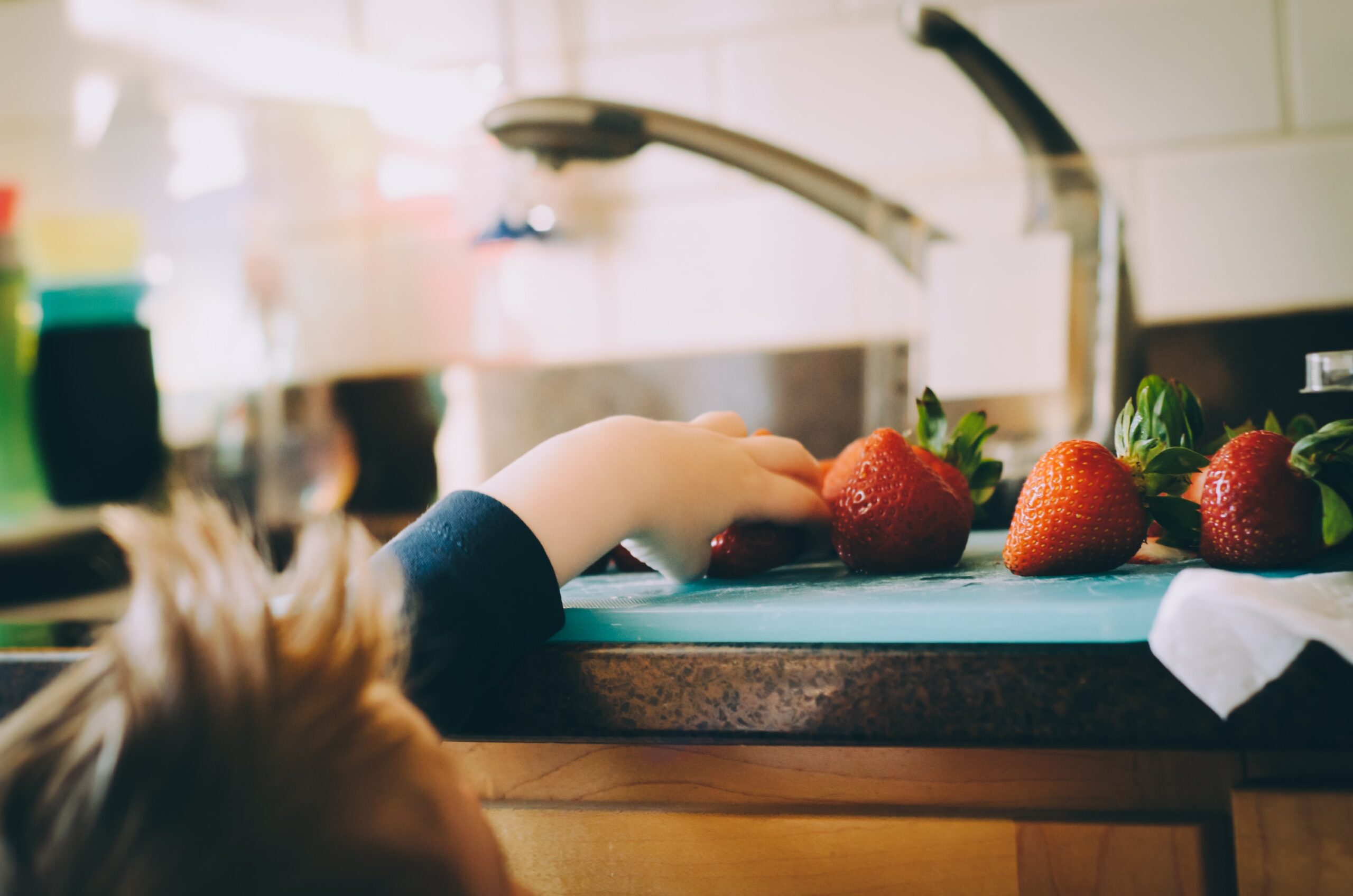This post may contain affiliate links. If you shop from one of our links, we may earn a commission.
Every kid’s favorite topic: poop! However, not pooping is a serious issue and can be very stressful for both parents and kids. As a parent, I too have experienced my child struggling with constipation. You feel so bad because you know they are so uncomfortable and you feel helpless. But let’s talk about high-fiber foods if your child is constipated and what causes constipation.
What is constipation?
According to the National Institutes of Health, having two or fewer bowel movements a week can be classified as constipation. Some kids don’t have to go daily, and that’s okay if that’s their norm. The frequency of bowel movements will begin to decrease as your infant transitions to a toddler. In addition, the color and consistency of bowel movements can also vary depending on your child’s diet.
How do I know if my child is constipated?
Symptoms of constipation include:
- Fewer than 2-3 bowel movements per week
- Straining to pass a bowel movement
- Hard, pellet-like stools
- Abdominal pain
What causes constipation?
Constipation can develop because a child has a fear of having a bowel movement on the toilet, they are embarrassed to go in public spaces or doesn’t want to stop what they’re doing to use the restroom. In addition, constipation can also occur due to a lack of fiber and fluid in a child’s diet. This isn’t entirely uncommon to see amongst picky eaters.
How much fluid should my child drink?
Consuming plenty of water is an important part of promoting regular bowel movements. As a registered dietitian, I calculate fluid needs for kids based on weight. This calculation can be a bit confusing and hard to remember. An easy way to determine how much fluid your child needs is to provide 8 oz (1 cup) of water equal to their age. This does not include beverages that come from milk, juice, etc.
For example:
- 1 year old = 1 cup water
- 2 year old = 2 cups water
- 3 year old = 3 cups water
- 4 year old = 4 cups water
- 5 year old = 5 cups water
- 6 year old = 6 cups water
- 7 year old = 7 cups water
- 8 years and above = minimum of 8 cups water (or 64 oz per day)
Prune juice is an effective beverage for many kids. In addition, starting the day with a warm beverage can also help stimulate regularity.

Does physical activity matter if my child is constipated?
Yes! Studies show that at least 30 minutes of physical activity per day can help the digestive tract move foods along. Focus on decreasing screen time and encouraging being active. Kids sit a lot during the school day, in that case, the added exercise at the end of the day is beneficial. Consider activities that your family enjoys to make exercise fun – swimming, hiking, bike riding, playing tennis, snowshoeing, going to a park, or enjoying a family walk. Exercise is always more fun as a family!
What is fiber?
Fiber, also known as roughage, is not digested by the body. It passes through your digestive tract to help ease bowel movements. There are two types of fiber: soluble and insoluble. Soluble fiber is found primarily in fruits and vegetables. Soluble fiber dissolves easily in water to form a gel-like substance to help soften stools.
Insoluble fiber is found primarily in grains and cereals. It does not dissolve in water. It works by trapping water to help harden stools and allow stools to pass more easily.
How much fiber does my child need?
Recommendations for daily fiber intake are not available for children less than 1 year of age. Talk to your pediatrician if your infant is suffering from constipation. They may suggest making changes to your infant’s formula or breast milk depending on their findings. Fiber recommendations vary based on the child’s age:
- Children 1 to 3 years: 19 grams of fiber/day
- Children 4 to 8 years: 25 grams of fiber/day
- Boys 9 to 13 years: 31 grams of fiber/day
- Girls 9 to 13 years: 26 grams of fiber/day
- Boys 14 to 19 years: 38 grams of fiber/day
- Girls 14 to 19 years: 26 grams of fiber/day
What are foods high in fiber?
Whole grains, nuts, legumes, fruits, and vegetables are all good sources of fiber. Leaving the skin on produce, such as apples, is a great way to provide additional fiber. Fruit with seeds also increases fiber content. Search for whole grain products by looking at the ingredient list. Many products can say they are whole grain products, but a very small amount of that item was actually made with whole grains. A whole-grain bread, for example, should have “whole grain” listed as the first ingredient. Ingredients are listed in order of dominance on nutrition labels.
Here are some examples of the fiber content of various foods:
- 1/2 cup of raspberries = 4 grams fiber
- 1 small banana = 3 grams fiber
- Around 12 almonds = 2 grams fiber
- 1/2 cup corn = 2 grams fiber
- 1 medium pear with skin = 5.5 grams fiber
- 10 dried prunes = 6 grams fiber
- 1/2 cup cooked broccoli = 2.3 grams fiber
- 1 cup boiled pinto beans = 14.7 grams fiber
- 1 cup Cheerios = 3 grams fiber
- 1 cup cooked whole wheat spaghetti noodles = 6.3 grams fiber
- 1 cup cooked brown rice = 3.5 grams fiber
- 1/2 cup kidney beans = 14 grams fiber
- 1 cup cubed sweet potatoes = 4 grams fiber
- 1 slice whole wheat bread = 2 grams fiber

How do I read nutrition labels for fiber?
Dietary fiber is listed under the “Total carbohydrates” section. An excellent source of fiber is 5 grams or more per serving. Your goal should be at least 3 grams per serving of dietary fiber.
Most Americans, both kids and adults, don’t consume enough fiber in their diet. When you’re ready to start increasing your child’s diet with fiber-rich foods, be sure to start slowly and increase their intake gradually. Avoid increasing your child’s fiber intake by more than 5 grams of fiber per day. Suddenly adding a lot of fiber than your child is used to can cause increased abdominal pain and bloating. I also recommend being cautious with added sources of fiber such as inulin or chicory root. These can be added to products to enhance the fiber content, but oftentimes cause increased abdominal pain or bloating.
What are constipating foods?
When your child is constipated, you want to be cautious to avoid too many constipating foods. Think about what foods you typically offer your child. Does your child consume a dairy-heavy diet? Do they eat a lot of refined grains such as white bread, white rice, white noodles, or baked goods made from white flour? Is their diet really low in fiber? Dairy can be constipating for some kids if they tend to consume a high volume of it.
The BRAT diet is a diet that can assist with diarrhea -but one to avoid if constipated. This diet includes bananas, rice, applesauce, and toast (white bread). High-fat foods, such as those rich in oil, butter, or grease, can slow gut motility and make constipation worse. Try to avoid or limit these foods and high-fat fast foods while your child is struggling with constipation.
If my child is constipated, should I give fiber supplements?
It is always best if your child’s nutrients can come in the form of food first. There are definitely instances where children are very picky and just aren’t able to consume enough fiber at this time despite your best efforts. I always recommend starting with what we know can help – fiber, water, physical activity- and then consider talking to your pediatrician about fiber supplements.
How do I get my picky eater to eat more high fiber foods?
I get it, adding fiber to your child’s diet is not easy, let alone if they are a fussy eater already. Download my ultimate Picky Eating Guide to discover the best ways to enhance your child’s food repertoire. Sometimes it takes being creative. For example, veggies cut into fun shapes somehow taste better. Or maybe it takes sneaking them into other foods. I like my kids to know what’s in their food, but sneaking food in on occasion can help them start experiencing new tastes.
But the most important thing when introducing new foods or trying to get your child to include more variety is to keep providing opportunities for them to try it and be exposed to it. Keep meals free of stress and force-feeding. Allow them to lick the food, chew it and spit it out, play with the food, etc. to help them become familiar with the taste, smell, and consistency.
Here are some fun and simple ways to incorporate high fiber foods:
- Add fruit and/or vegetables into smoothies
- Mix whole-grain pasta noodles with white noodles
- Mix half zucchini noodles with spaghetti noodles
- Make energy bites with dried fruit, chia seeds, and oatmeal
- Add pureed vegetables to pasta sauces
- Use whole wheat tortillas in place of flour tortillas
- Make trail mixes together of dried fruit, Cheerios, nuts, and chocolate chips
- Add chia seeds or flax seeds to muffins, breads, or yogurt
- Look for high fiber cereals to enjoy at breakfast and use for snack mixes
- Try chickpea noodles such as Banzo noodles
In Summary
It is equally as hard on parents when your child is constipated. As you work on ways to better help them with regular bowels, make sure to gradually increase fiber intake, physical activity, and water consumption. Be sure to talk to your physician if your child appears in discomfort or is struggling with chronic constipation.

